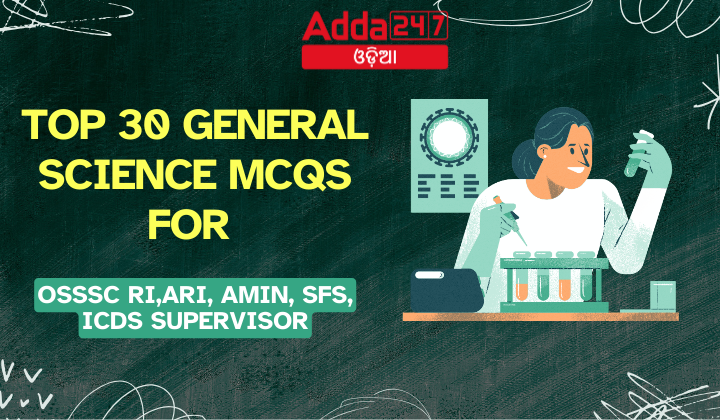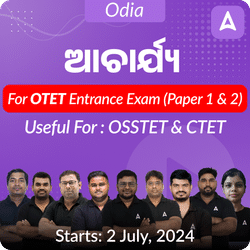General Studies is a crucial component of various competitive exams like OSSSC RI, ARI, Amin, SFS, and ICDS Supervisor. It encompasses a wide range of topics, from current affairs to history, geography, polity, and more. To excel in these exams, it’s essential to have a strong grasp of general knowledge. Here, we present a curated list of the top 30 Multiple Choice Questions (MCQs) that are commonly encountered in these exams, covering diverse subjects to help you prepare effectively.
Top 30 General Science MCQS For OSSSC RI,ARI, Amin, SFS, ICDS Supervisor
Q1) The primary function of the pollen tube is to transport:
[A] Pollen Grains
[B] Sperm Cells
[C] Eggs
[D] All of them
Correct Answer: B [Sperm Cells]
Explanation: The pollen tube transports sperm cells from the pollen grain to the ovule in seed plants.
Q2) Which organisms are primarily known as decomposers in an ecosystem?
[A] Bacteria
[B] Fungi & Bacteria
[C] Algae
[D] None of the above
Correct Answer: B [Fungi & Bacteria]
Explanation: Fungi and bacteria decompose dead organic material, recycling nutrients back into the ecosystem.
Q3) Where does digestion occur in amoeba?
[A] Food vacuole
[B] Mitochondria
[C] Pseudopodia
[D] Chloroplast
Correct Answer: A [Food vacuole]
Explanation: Amoeba digests food within the food vacuole.
Q4) Which organisms break down food materials outside their bodies and then absorb it?
[A] Mushroom, Green plants, Amoeba
[B] Yeast, Mushroom, Bread mould
[C] Paramecium, Amoeba, Cuscuta
[D] Cuscuta, Lice, Tapeworm
Correct Answer: B [Yeast, Mushroom, Bread mould]
Explanation: Yeast, mushroom, and bread mould break down food materials externally before absorbing them.
Q5) What indicates the presence of starch when iodine is added to rice water?
[A] Blue-black color
[B] No color change
[C] Red color
[D] Yellow color
Correct Answer: A [Blue-black color]
Explanation: Iodine reacts with starch, turning blue-black.
Q6) The respiratory pigment in humans is:
[A] Carotene
[B] Chlorophyll
[C] Haemoglobin
[D] Mitochondria
Correct Answer: C [Haemoglobin]
Explanation: Haemoglobin in blood binds oxygen for transport.
Q7) Which of the following structures in humans controls the size of the pupil?
[A] Retina
[B] Iris
[C] Cornea
[D] Lens
Correct Answer: B [Iris]
Explanation: The iris adjusts the pupil’s size to regulate the amount of light entering the eye.
Q8) The contraction and expansion of the food pipe’s walls is called:
[A] Translocation
[B] Transpiration
[C] Peristaltic movement
[D] Digestion
Correct Answer: C [Peristaltic movement]
Explanation: Peristaltic movements propel food through the digestive tract.
Q9) Which part of the plant is involved in photosynthesis?
[A] Roots
[B] Stems
[C] Leaves
[D] Flowers
Correct Answer: C [Leaves]
Explanation: Leaves contain chlorophyll, essential for photosynthesis.
Q10) What is the role of chlorophyll in photosynthesis?
[A] Absorbs water
[B] Absorbs sunlight
[C] Stores starch
[D] Releases oxygen
Correct Answer: B [Absorbs sunlight]
Explanation: Chlorophyll absorbs light energy to drive photosynthesis.
Q11) Which of the following affects the velocity of a rocket?
[A] Exhaust speed of gases
[B] Natural log of the initial mass to current mass ratio
[C] Both A and B
[D] Length of the rocket
Correct Answer: C [Both A and B]
Explanation: The rocket’s velocity depends on exhaust speed and the mass ratio.
Q12) 1 nautical mile is equivalent to:
[A] 1.44 x 1000 m
[B] 1.852 x 100 m
[C] 1.852 x 1000 m
[D] 1.44 x 100 m
Correct Answer: C [1.852 x 1000 m]
Explanation: A nautical mile is 1.852 kilometers.
Q13) The universal gravitational constant represents:
[A] The force of attraction between unit masses at unit distance
[B] Twice the force of attraction between unit masses at unit distance
[C] Half the force of attraction between unit masses at unit distance
[D] Ten times the force of attraction between unit masses at unit distance
Correct Answer: A [The force of attraction between unit masses at unit distance]
Explanation: It quantifies gravitational attraction between unit masses at unit distance.
Q14) What factors affect the value of acceleration due to gravity?
[A] Shape of the Earth
[B] Height above Earth’s surface
[C] Axial rotation of the Earth
[D] All of the above
Correct Answer: D [All of the above]
Explanation: Gravity varies with Earth’s shape, height, and rotation.
Q15) Buoyancy depends on:
[A] Density of the fluid
[B] Volume of the submerged body
[C] Both A and B
[D] None of the above
Correct Answer: C [Both A and B]
Explanation: Buoyancy is affected by fluid density and the submerged body’s volume.
Q16) According to Ohm’s law, if resistance is doubled, the current will:
[A] Double
[B] Halve
[C] Increase four times
[D] Remain unchanged
Correct Answer: B [Halve]
Explanation: Doubling resistance reduces current by half, as per Ohm’s law.
Q17) The minimum number of logic gates in a VLSI circuit is:
[A] 10
[B] 100
[C] 1000
[D] 10000
Correct Answer: C [1000]
Explanation: VLSI circuits contain more than 1000 logic gates.
Q18) The acceleration due to gravity is zero at:
[A] Earth’s surface
[B] Center of the Earth
[C] Poles
[D] Equator
Correct Answer: B [Center of the Earth]
Explanation: Gravity is zero at Earth’s center.
Q19) Which of these devices measures electric current?
[A] Voltmeter
[B] Ammeter
[C] Ohmmeter
[D] Barometer
Correct Answer: B [Ammeter]
Explanation: Ammeters measure electric current.
Q20) What type of mirror is used in a car’s rearview mirror?
[A] Convex
[B] Concave
[C] Plane
[D] Spherical
Correct Answer: A [Convex]
Explanation: Convex mirrors provide a wider field of view.
Q21) The basis of the modern periodic table is:
[A] Atomic mass
[B] Atomic number
[C] Number of nucleons
[D] All of the above
Correct Answer: B [Atomic number]
Explanation: Elements are arranged by increasing atomic number.
Q22) The most reactive element in group 17 is:
[A] Oxygen
[B] Sodium
[C] Fluorine
[D] Magnesium
Correct Answer: C [Fluorine]
Explanation: Fluorine is the most reactive halogen.
Q23) Which order is correct for atomic radii of oxygen, fluorine, and nitrogen?
[A] O < F < N
[B] N < F < O
[C] O < N < F
[D] F < O < N
Correct Answer: D [F < O < N]
Explanation: Fluorine has the smallest, and nitrogen the largest atomic radius among the three.
Q24) The element X forms a chloride XCl2, a solid with a high melting point. X is likely in the same group as:
[A] Na
[B] Mg
[C] Al
[D] Si
Correct Answer: B [Mg]
Explanation: Magnesium forms MgCl2, a similar compound.
Q25) Electropositive character of elements decreases as you move:
[A] Left to right across a period
[B] Right to left across a period
[C] Top to bottom down a group
[D] None of the above
Correct Answer: A [Left to right across a period]
Explanation: Electropositive character decreases across a period due to increasing nuclear charge.
Q26) Group 18 elements are also known as:
[A] Noble gases
[B] Alkali metals
[C] Alkali earth metals
[D] Halogens
Correct Answer: A [Noble gases]
Explanation: Group 18 contains noble gases, which are inert.
Q27) Transition metals are located in groups:
[A] 1 to 2
[B] 13 to 18
[C] 3 to 12
[D] 1 to 8
Correct Answer: C [3 to 12]
Explanation: Transition metals are found in groups 3 to 12.
Q28) An element with electronic configuration 2, 8, 4 belongs to:
[A] 4th group
[B] 2nd group
[C] 14th group
[D] 18th group
Correct Answer: C [14th group]
Explanation: This configuration matches group 14 elements.
Q29) An element with 2 completely filled shells is:
[A] Helium
[B] Neon
[C] Calcium
[D] Boron
Correct Answer: B [Neon]
30) What is the other name for group 18 elements in the periodic table?
[A] Noble gases
[B] Alkali metals
[C] Alkali earth metals
[D] Halogens
Correct Answer: [A] Noble gases
Explanation: Group 18 elements are also known as noble gases because they are inert and have very low reactivity due to their stable electron configurations.










